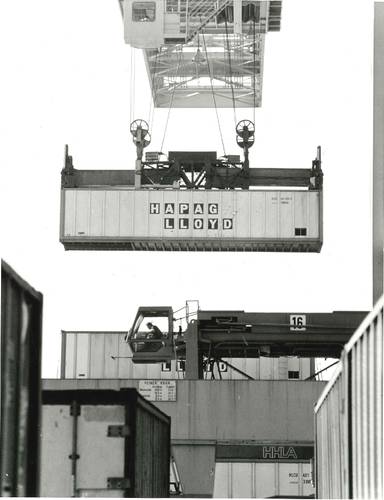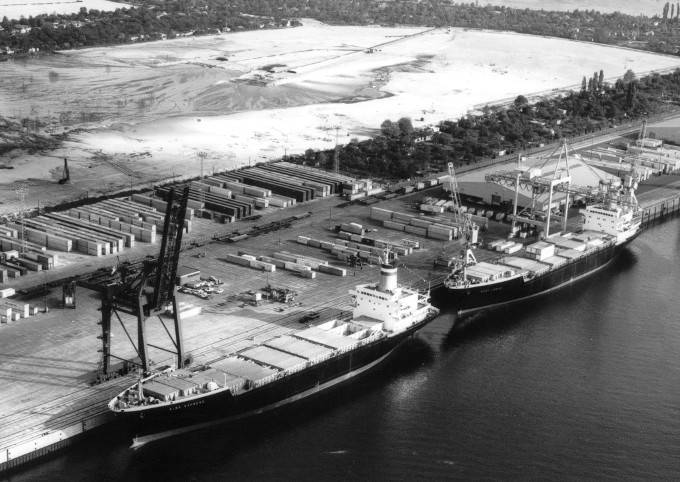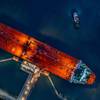50 years after the beginning of modern container shipping in Germany, international trade is handled by 6,397 containerships, with a capacity of 21.1 million TEU. Hapag-Lloyd’s container fleet numbers among the largest in the industry.
The revolution reached Germany 50 years ago. And even if no gunshots were heard, there was still a loud bang. On May 5, 1966, the Fairland, owned by the American shipping company Sea-Land, called at Bremen’s Überseehafen (overseas port). On the next day, it had just started putting the first containers down on German soil when just the second of these strange new steel boxes slid out of its onboard harness and destroyed a brand-new tractor. Luckily there were only a few witnesses present to see a potentially bad omen for containerized shipping in this mishap.
Invented just 10 years earlier in America, containerized shipping was still in its infancy. But, as we all know now, even this misfortune couldn’t slow its glorious march toward triumph – even if there was still a considerable amount of skepticism in Germany about this new system of transport. As one contemporary eyewitness recounted half a century later: “It was written off as American craziness, as a flash in the pan.”
The freight forwarder Malcom McLean is regarded as the father of modern container transport. In the mid-1950s, he started using the first uniform-sized containers, initially for traffic along the U.S. East Coast. Ten years later, he transported the first boxes by sea to Europe with his Sea-Land shipping company. On May 5, 1966, his ship the Fairland called at its first German port, the Überseehafen (overseas port) of Bremen, with 255 containers on board.
At the time, Germany’s two leading shipping companies were Hapag and North German Lloyd (NDL). Though they were already closing collaborating in many areas, their merger into Hapag-Lloyd still lay a few years ahead. The container revolution eventually became an important catalyst for this fusion. But, in the early days, the advance of containerization was primarily setting off alarm bells in Hamburg and Bremen, the companies’ respective homes. “The development of so-called container transport is proceeding at headlong speed,” warned Lloyd’s annual report in 1965. At this point, the company was still hoping for “an evolutionary development” with “semi-containerships.” But such hopes were in vain, as things obviously turned out differently. In fact, Hapag and NDL would quickly take up leading positions in this transition. For example, in June 1966, NDL performed Germany’s first combined door-to-door transport, from Stuttgart to New York, with a 20-foot container.
And already one year later, the two long-established shipping companies agreed that conventional shipping had no future in the North Atlantic. So both of them ordered two full containerships, each with a capacity of 736 standard container units (TEU), from the shipbuilders Blohm+Voss, based in Hamburg, and Bremer Vulkan, in Bremen. Then, in the fall of 1968, the Weser Express and the Elbe Express opened the first European fully containerized service over the Atlantic to New York. The Hapag-Lloyd Container Linien, in which both companies pooled their container businesses, was a decisive step on the path to their complete coalescing into Hapag-Lloyd in 1970.
Sixty years after the beginning of modern container shipping and 50 years after the first container was unloaded in Germany, this “flash in the pan” has turned out to have extremely good staying power. A large part of the international trade is handled by the 6,397 containerships across the world, with a combined capacity of 21.1 million TEU. With more than 1.1 million steel boxes measuring 20 or 40 feet (for a total of 1.6 million TEU), Hapag-Lloyd’s container fleet numbers among the largest in the industry.
Another issue generating a lot of interest and excitement these days is the development of larger ship sizes. Ten years ago, when the 50th anniversary of container shipping was celebrated, the world was still marveling at 9,000 TEU vessels. But now the newest generation of ships, the ultra large container ships (ULCSs), can carry more than 19,000 standard boxes. Does this mean we’ve finally reached the end of the story in terms of ship size? Well, we will most likely have an answer to this question by 2026, when we celebrate the 70th anniversary of container shipping.















